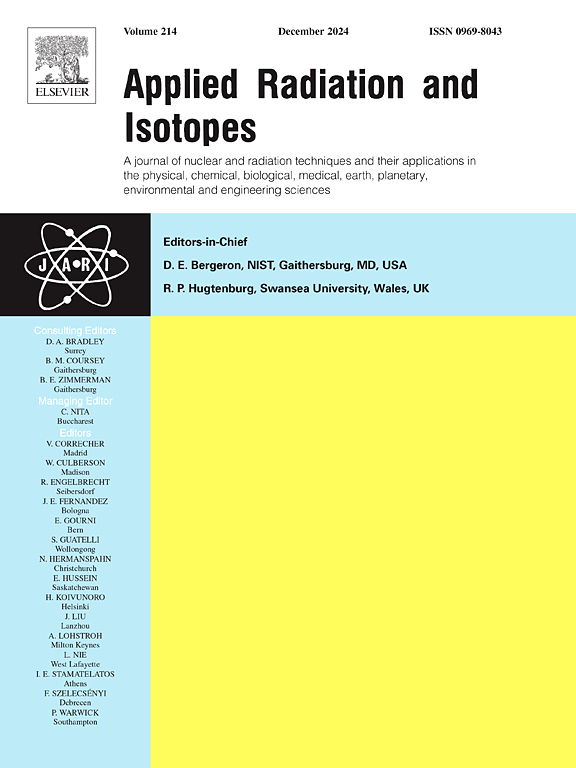新型非热释光CaSO4:Dy剂量计
IF 1.6
3区 工程技术
Q3 CHEMISTRY, INORGANIC & NUCLEAR
引用次数: 0
摘要
本文首次报道了一种低成本、环境友好的方法合成的自凝聚球团状CaSO4:Dy荧光粉的非热释光余辉剂量学性能。研究了在0.06 ~ 8.0 Gy剂量范围内β粒子辐照样品的热释光(TL)和余辉(AG)。特征TL发光曲线包括134°C时的强烈TL最大值,200°C时的肩部和447°C时的最大值。CaSO4:Dy在0.06 Gy ~ 8.0 Gy范围内表现出高度敏感的24 h AG响应。在不需要辐照前退火的情况下,在重复辐照-读出循环中观察到TL和AG响应的显著再现性。合成的CaSO4:Dy具有良好的性能,可作为基于ag的剂量计用于实时辐射检测和剂量测定。此外,该荧光粉可以作为长持久性荧光粉(LPP)应用,是其他可用的长持久性荧光粉的一种具有成本效益的替代品。本文章由计算机程序翻译,如有差异,请以英文原文为准。
Novel non-thermoluminescent CaSO4:Dy dosimeters
The non-thermoluminescence afterglow-based dosimetry performance of self-agglomerating pellet-shaped CaSO4:Dy phosphors synthesized through a low-cost, environmentally friendly method is first reported. Thermoluminescence (TL) and afterglow (AG) were analyzed in samples exposed to beta particle irradiation in the dose range from 0.06 to 8.0 Gy. Characteristic TL glow curves consist of an intense TL maximum at 134 °C, a shoulder at 200 °C, and a maximum at 447 °C. CaSO4:Dy exhibits a highly sensitive AG response for 24 h with linear behavior from 0.06 Gy to 8.0 Gy. A remarkable reproducibility of both the TL and the AG response was observed in repeated irradiation–readout cycles with no need for pre-irradiation annealing. The synthesized CaSO4:Dy exhibits promising properties to be used as an AG-based dosimeter for real-time radiation detection and dosimetry. Moreover, this phosphor might be applied as a long persistent phosphor (LPP), being a cost-effective alternative to other available LPPs.
求助全文
通过发布文献求助,成功后即可免费获取论文全文。
去求助
来源期刊

Applied Radiation and Isotopes
工程技术-核科学技术
CiteScore
3.00
自引率
12.50%
发文量
406
审稿时长
13.5 months
期刊介绍:
Applied Radiation and Isotopes provides a high quality medium for the publication of substantial, original and scientific and technological papers on the development and peaceful application of nuclear, radiation and radionuclide techniques in chemistry, physics, biochemistry, biology, medicine, security, engineering and in the earth, planetary and environmental sciences, all including dosimetry. Nuclear techniques are defined in the broadest sense and both experimental and theoretical papers are welcome. They include the development and use of α- and β-particles, X-rays and γ-rays, neutrons and other nuclear particles and radiations from all sources, including radionuclides, synchrotron sources, cyclotrons and reactors and from the natural environment.
The journal aims to publish papers with significance to an international audience, containing substantial novelty and scientific impact. The Editors reserve the rights to reject, with or without external review, papers that do not meet these criteria.
Papers dealing with radiation processing, i.e., where radiation is used to bring about a biological, chemical or physical change in a material, should be directed to our sister journal Radiation Physics and Chemistry.
 求助内容:
求助内容: 应助结果提醒方式:
应助结果提醒方式:


